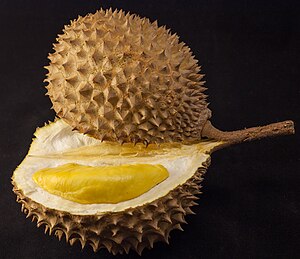Cookbook:Durian
| Durian | |
|---|---|
 | |
| Category | Fruits |
Cookbook | Recipes | Ingredients | Equipment | Techniques | Cookbook Disambiguation Pages | Ingredients | Fruit
Durian is a green, spiny fruit from Southeast Asia.[1]
Characteristics
[edit | edit source]The fruit of the durian is large (5–10 lbs) and ovoid, with a hard and spiky yellow-green exterior.[1][2][3][4] The inside of the fruit contains multiple fleshy, yellow segments with single seeds.[2] This flesh can be very soft and smooth in texture or fibrous, depending on the variety.[1][3][5][6] However, the most famous property of the durian is its smell, which is extremely pungent and compared to various odors like skunk, cheese, onion, or rotting.[1][3][4]
The durian falls off the tree once ripe,[1] and it continues to ripen further for a few days afterwards, growing more intense in smell as it does.[4] It may also undergo slight fermentation during this time.[1] Once opened and exposed to the air, the flesh will begin to degrade.[2]
Selection and storage
[edit | edit source]In Southeast Asia, durian is widely available fresh. A few recommendations are given for evaluation of a durian's ripeness. One is to knock on the fruit and select those with a hollow sound,[6] while another is to examine the rind and see if it has started to crack—this is cited as a sign of ripeness.[4][5] The stem should look solid and not overly dried, which would indicate lack of freshness.[4] In general, the durian will become overripe by 1 week after falling from the tree.[4] The aroma of durian becomes more pronounced with increasing ripeness, and different individuals may prefer the fruit at different stages of ripening.[5] Once opened, a durian should be eaten quickly.
Durians can sometimes be found in general supermarkets in Western countries, frozen and thickly wrapped in plastic.
Preparation
[edit | edit source]A durian is opened by splitting it along natural sections. You might be able to see them on the outside as places where the spines run parallel. A durian can be forced open with the hands. Though not needed, a sturdy knife can be helpful to get things started.
Use
[edit | edit source]Durian fruit is used to flavour a wide variety of sweet edibles such as traditional Malay candy, ice kachang, rose biscuits, cakes, and, with a touch of modern innovation, ice cream, milkshakes, mooncakes and even cappuccino. It can also be incorporated into pancakes, jams, and custard.[2][6] Pulut durian is glutinous rice steamed with coconut milk and served with ripened durian. In Sabah, red durian (D. dulcis) is fried with onions and chilli and served as a side dish. Tempoyak refers to fermented durian, usually made from lower quality durian that is unsuitable for direct consumption. Tempoyak can be eaten either cooked or uncooked, is normally eaten with rice, and can also be used for making curry. Sambal tempoyak is a Sumatran dish made from the fermented durian fruit, coconut milk, and a collection of spicy ingredients known as sambal.
Recipes
[edit | edit source]References
[edit | edit source]- ↑ a b c d e f Davidson, Alan (2014-01-01). Jaine, Tom (ed.). The Oxford Companion to Food. Oxford University Press. doi:10.1093/acref/9780199677337.001.0001. ISBN 978-0-19-967733-7.
- ↑ a b c d Rinsky, Glenn; Rinsky, Laura Halpin (2008-02-28). The Pastry Chef's Companion: A Comprehensive Resource Guide for the Baking and Pastry Professional. John Wiley & Sons. ISBN 978-0-470-00955-0.
- ↑ a b c Friberg, Bo (2016-09-13). The Professional Pastry Chef: Fundamentals of Baking and Pastry. Wiley. ISBN 978-0-470-46629-2.
- ↑ a b c d e f Kipfer, Barbara Ann (2012-04-11). The Culinarian: A Kitchen Desk Reference. Houghton Mifflin Harcourt. ISBN 978-0-544-18603-3.
- ↑ a b c "Durian". Serious Eats. Retrieved 2024-06-27.
- ↑ a b c "Singapore Stories: How I Learned to Like Durian". Serious Eats. Retrieved 2024-06-27.